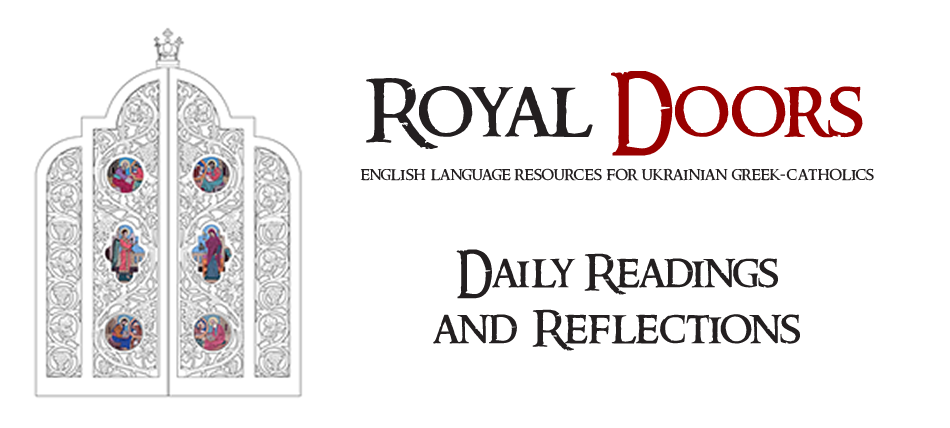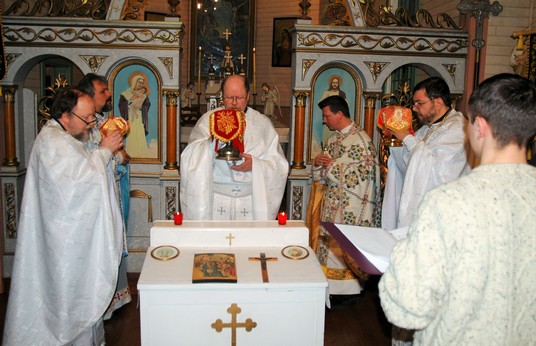by Brent Kostyniuk
A priest once told me how he had been chastised by an upset parishioner because he prayed for the Orthodox Church during the Divine Liturgy. We both got a chuckle out of the story; however, it did point to a misunderstanding. The prayer, repeated several times during the Divine Liturgy of St. John Chrysostom, is intended for something quite different from the parishioner’s understanding.
Specifically, during the Ektenia of Fervent Supplication, the following petition is prayed by the priest. “We also pray for the people here present who await Your great and bountiful mercies, for those who have been kind to us, and for all orthodox Christians.” The expression is repeated shortly after during the Great Entrance when the priest offers a blessing to the faithful.
Why then, this emphasis on “orthodox” immediately before the most important part of the Divine Liturgy, the Anaphora (Consecration), by Chrysostom.
To begin with, what is “orthodox?” The word comes from the Greek, orthodoxos, meaning “of the right opinion,” and was first used to identify true doctrine and its adherents by the Greek Fathers in the early 4th-century. To understand the importance of the word, we need to understand the state of Christianity at the time.
When he was Archbishop of Constantinople from 398 to 404, St. John Chrysostom harmonized the liturgical life of the Church with the Divine Liturgy which bears his name to this day. It draws from the work of the Cappadocian Fathers who sought to combat heresy and define Trinitarian theology. It probably has its basis in a liturgy used originally by the School of Antioch, Chrysostom having been a deacon and priest in Antioch. Over time, because it was the liturgy celebrated at the Church of Holy Wisdom, Hagia Sophia, the mother church of Byzantium, it became the usual Divine Liturgy in the churches throughout that empire.
Prior to that, the First Council of Nicaea was convened by the emperor Constantine I in 325. The Emperor wanted to establish universal agreement on the controversial issue of the relation between Jesus Christ and God the Father. At the time, the heresy of Arianism was raging. It stemmed from the teaching of Alexandrian priest, Arius (c. 250 – 336), who taught that Jesus was not co-eternal with His Father, but rather a created being with a definite origin in time. In Arius’s words, “There was a time when the Son was not.”
The result was the original Nicene Creed, later modified by the First Council of Constantinople of 381. Since that time, the Creed has been recognized as the definitive expression of Christian Trinitarian belief.
The council described “God’s only-begotten Son,” Jesus Christ, as of the same substance with God the Father. The term they used for this mystery is homoousios, which is Greek and means “of one substance.” Some English language versions of the Creed express this with the word “consubstantial,” which, incidentally, has no other meaning than its theological one.
The original version of the Nicene Creed from the first Council includes a condemnation of unbelievers, which was removed in the final version. “But those who say, ‘there was a time when he was not,’ and ‘He was not before he was made,’ and ‘He was made out of nothing’ or ‘He is of another substance’ or ‘essence’ or ‘The Son of God is created’ or ‘changeable’ or ‘alterable’ – they are condemned by the holy catholic and apostolic Church.”
Interestingly, the Nicene Creed is accepted as the authoritative statement of Christian faith not only by the Catholic Church, but by the Orthodox Churches, Oriental Orthodoxy, the Churches of the East, and much of Protestantism including the Anglican communion.
Thus, while several churches include the word Orthodox in their names, the word simply refers to the faith which all true believers hold dear and which, ultimately, unites us. For St. John Chrysostom, to be orthodox meant to reject all heresies and that is why he reminds us of that in the Divine Liturgy. To reinforce that faith, he also included the Nicene Creed for the faithful to pray at each Liturgy.
More recently, St. John Paul II expressed his desire for this unity of faith at the close of the Jubilee Year of 2000 in his Apostolic Letter Novo Millennio Ineunte. “In the perspective of our renewed post-Jubilee pilgrimage, I look with great hope to the Eastern Churches, and I pray for a full return to that exchange of gifts which enriched the Church of the first millennium. May the memory of the time when the Church breathed with ‘both lungs’ spur Christians of East and West to walk together in unity of faith and with respect for legitimate diversity, accepting and sustaining each other as members of the one Body of Christ.”
So far from being divisive, orthodox is that which binds us as Christians. It is part of that which allows the Church to breathe through both lungs.

